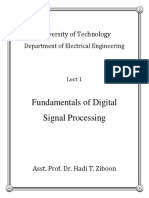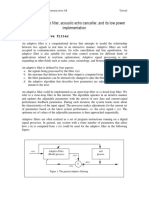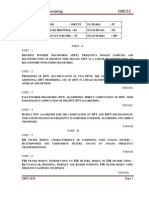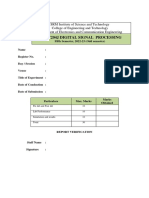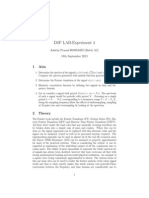Discrete Fourier Transform Gui: 1. Introduction & Purpose
Discrete Fourier Transform Gui: 1. Introduction & Purpose
Uploaded by
Luis Humberto Martinez PalmethCopyright:
Available Formats
Discrete Fourier Transform Gui: 1. Introduction & Purpose
Discrete Fourier Transform Gui: 1. Introduction & Purpose
Uploaded by
Luis Humberto Martinez PalmethOriginal Description:
Original Title
Copyright
Available Formats
Share this document
Did you find this document useful?
Is this content inappropriate?
Copyright:
Available Formats
Discrete Fourier Transform Gui: 1. Introduction & Purpose
Discrete Fourier Transform Gui: 1. Introduction & Purpose
Uploaded by
Luis Humberto Martinez PalmethCopyright:
Available Formats
DISCRETE FOURIER TRANSFORM GUI
1. INTRODUCTION & PURPOSE
This script aims to change a discrete signal input, and more precisely an earthquake
accelerogram, from time domain to frequency domain applying the Discrete Fourier
Transform.
Frequency Domain Representation, F(w), gives amplitude of the real and imaginary parts
of the sinusoid at each frequency. By knowing the solution in the frequency domain, you
can get the solution for any signal in the time domain.
On this basis, the script obtains the signal in the the amplitude related to each frequency
within the considered range of values.
2. INPUT DATA
The input data is the signal we want to study, defined on a discrete set of points (N
sampled values associated with a sampling interval, ∆), which is introduced as an ASCII
file loaded in the GUI.
The sampling interval has a very high significance. For any sampling interval, there is also
a special frequency fc, called the Nyquist Critical Frequency, given by:
The Nyquist Critical Frequency is important for two related, but distinct, reasons. One is
the remarkable fact known as the Sampling Theorem: “If a continuous function h(t),
sampled at an interval ∆, happens to be bandwidth limited to frequencies smaller in
magnitude than fc, | f | ≤ fc ”.
The other is the fact that ‘information content’ of a bandwidth limited function is, in some
sense, infinitely smaller than that of a general continuous function. Therefore, the effect of
sampling a continuous function that is not bandwidth limited to less than the fc is that any
frequency component outside of the frequency range [-fc, fc] is aliased (falsely translated,
also called foldover or biasing) into that range by the very act of discrete sampling.
In order to overcome the problem of aliasing we must sample at a rate sufficiently rapid to
give at least two points of the highest frequency present and we must limit our calculation
to the frequency range [-fc, fc].
The sampling can be improved by doubling the number of signals per second. The script
gives the possibility of doing this by interpolating the values of the signal provided by the
user.
CRISTINA M. VILA (vilamartinezcristina@hotmail.com) 1
On this basis, we generate the Fourier transform at discrete frequencies:
The complex numbers Xk represent the extent and phase of different sinusoidal
components of the input signal xn.
3. OUTPUT DATA (Solution)
The calculation of the Discrete Fourier Transform is performed applying the internal
function fft(signal,N). In order to increase the performance of fft when the length of the
signal is not a power of 2 the script uses the internal functions nextpow2.
The user is given the possibility to either represent the amplitude associated with each
frequency or the real or imaginary terms. The default value for the abscissa will be the
Natural Frequency (Hz), but the script allows the user to change to the period (T=1/f) by
selecting the check box “x-axis, Period”.
Lastly, the script offers the possibility to store the results obtained by clicking ‘Create a file’.
The GUI will request a filename and a directory and automatically create a .dat file which
will contain all the data mentioned above.
4. FILE LIST
- DFT.m
- DFT.fig
- Accelerogram of el Centro earthquake:
- elcentro.dat
CRISTINA M. VILA (vilamartinezcristina@hotmail.com) 2
- Accelerograms of San Fernando earthquake (different components):
- 1971SanFernandoCastaicDOWN.dat
- 1971SanFernandoCastaicN21E.dat
- 1971SanFernandoCastaicN69W.dats
- 1971SanFernandoJPLDOWN.dat
- 1971SanFernandoJPLS08W.dat
- 1971SanFernandoJPLS82E.dat
CRISTINA M. VILA (vilamartinezcristina@hotmail.com) 3
You might also like
- Laboratory 3 Digital Filter DesignDocument8 pagesLaboratory 3 Digital Filter DesignModitha LakshanNo ratings yet
- ANSYS ACT API Reference Guide PDFDocument1,964 pagesANSYS ACT API Reference Guide PDFLuis Humberto Martinez PalmethNo ratings yet
- Simqke (Ucg-Es-00472)Document8 pagesSimqke (Ucg-Es-00472)Angel J. AliceaNo ratings yet
- Me'Scopeves Application Note #1: The FFT, Leakage, and WindowingDocument8 pagesMe'Scopeves Application Note #1: The FFT, Leakage, and Windowingho-faNo ratings yet
- Open Handed Lab Power Spectral Density: ObjectiveDocument3 pagesOpen Handed Lab Power Spectral Density: ObjectiveMiraniNo ratings yet
- Part1 - Chapter 3 - Edited-1Document4 pagesPart1 - Chapter 3 - Edited-1Kimbeng FaithNo ratings yet
- Exp#02 Analysing Biomedical Signal Using DFT and Reconstruct The Signal Using IDFTDocument6 pagesExp#02 Analysing Biomedical Signal Using DFT and Reconstruct The Signal Using IDFTMuhammad Muinul IslamNo ratings yet
- Sampling and AliasingDocument39 pagesSampling and AliasingDeepa SNo ratings yet
- EE 306 Matlab HW2Document1 pageEE 306 Matlab HW2aaal09No ratings yet
- Data Communication EXP 2 Student ManualDocument13 pagesData Communication EXP 2 Student ManualMohammad Saydul AlamNo ratings yet
- Filter Programs MatlabDocument8 pagesFilter Programs MatlabPreethi Sj100% (1)
- Matlab ActivityDocument2 pagesMatlab ActivityTatsuya ShibaNo ratings yet
- Stable System:: Bilinear TransformDocument7 pagesStable System:: Bilinear TransformSulaimanNo ratings yet
- Dr. Manzuri Computer Assignment 1: Sharif University of Technology Computer Engineering DepartmentDocument3 pagesDr. Manzuri Computer Assignment 1: Sharif University of Technology Computer Engineering DepartmentsaharNo ratings yet
- Lab-10 Fourier TransformDocument3 pagesLab-10 Fourier TransformAbdullah IbrahimNo ratings yet
- Matlab Activity-1Document2 pagesMatlab Activity-1Tatsuya ShibaNo ratings yet
- Low-Latency Convolution For Real-Time ApplicationDocument7 pagesLow-Latency Convolution For Real-Time ApplicationotringalNo ratings yet
- University of Kentucky: EE 422G - Signals and Systems LaboratoryDocument5 pagesUniversity of Kentucky: EE 422G - Signals and Systems Laboratoryamina sayahNo ratings yet
- FFTANALISIS-enDocument13 pagesFFTANALISIS-enRODRIGO SALVADOR MARTINEZ ORTIZNo ratings yet
- 1 Bit Sigma Delta ADC DesignDocument10 pages1 Bit Sigma Delta ADC DesignNishant SinghNo ratings yet
- A4: Short-Time Fourier Transform (STFT) : Audio Signal Processing For Music ApplicationsDocument6 pagesA4: Short-Time Fourier Transform (STFT) : Audio Signal Processing For Music ApplicationsjcvoscribNo ratings yet
- DSP LecturesDocument154 pagesDSP LecturesSanjeev GhanghashNo ratings yet
- Direction of Arrival Estimation AlgorithmsDocument14 pagesDirection of Arrival Estimation AlgorithmsilgisizalakasizNo ratings yet
- Lab 5 Long RepotDocument24 pagesLab 5 Long RepotAzie BasirNo ratings yet
- 7 SS Lab ManualDocument34 pages7 SS Lab ManualELECTRONICS COMMUNICATION ENGINEERING BRANCHNo ratings yet
- Matlab Training Session Vii Basic Signal Processing: Frequency Domain AnalysisDocument8 pagesMatlab Training Session Vii Basic Signal Processing: Frequency Domain AnalysisAli AhmadNo ratings yet
- Unit 1 Introduction To Digital Signal ProcessingDocument15 pagesUnit 1 Introduction To Digital Signal ProcessingPreetham SaigalNo ratings yet
- Signal ProcessingDocument40 pagesSignal ProcessingSamson MumbaNo ratings yet
- Tutorial: Adaptive Filter, Acoustic Echo Canceller, and Its Low Power ImplementationDocument6 pagesTutorial: Adaptive Filter, Acoustic Echo Canceller, and Its Low Power ImplementationkmleongmyNo ratings yet
- Ece V Digital Signal Processing (10ec52) NotesDocument160 pagesEce V Digital Signal Processing (10ec52) NotesVijay SaiNo ratings yet
- DC Lab FileDocument28 pagesDC Lab FileKrish JainNo ratings yet
- Fast Fourier Transform ReportDocument19 pagesFast Fourier Transform ReportKarabo LetsholoNo ratings yet
- How To Perform Frequency-Domain Analysis With Scilab - Technical ArticlesDocument8 pagesHow To Perform Frequency-Domain Analysis With Scilab - Technical ArticlesRadh KamalNo ratings yet
- Me'Scopeves Application Note #2: Waveform Integration & DifferentiationDocument8 pagesMe'Scopeves Application Note #2: Waveform Integration & Differentiationho-faNo ratings yet
- DWT PaperDocument6 pagesDWT PaperLucas WeaverNo ratings yet
- Exp-2 & 3-DSPDocument15 pagesExp-2 & 3-DSPSankalp SharmaNo ratings yet
- DSP Part A Question and AnswerDocument17 pagesDSP Part A Question and Answer21wj1a04a0No ratings yet
- Lab 03Document7 pagesLab 03Pitchaya Myotan EsNo ratings yet
- EEE 5502 Code 5: 1 ProblemDocument8 pagesEEE 5502 Code 5: 1 ProblemMichael OlveraNo ratings yet
- Adobe Scan Nov 30, 2022Document5 pagesAdobe Scan Nov 30, 2022Mohit soniNo ratings yet
- Journal 11Document6 pagesJournal 11Eccker RekcceNo ratings yet
- EE1/EIE1: Introduction To Signals and Communications MATLAB ExperimentsDocument9 pagesEE1/EIE1: Introduction To Signals and Communications MATLAB ExperimentsHemanth pNo ratings yet
- Wavelet Transform Approach To Distance: Protection of Transmission LinesDocument6 pagesWavelet Transform Approach To Distance: Protection of Transmission LinesthavaselvanNo ratings yet
- DSP LAB-Experiment 4: Ashwin Prasad-B100164EC (Batch A2) 18th September 2013Document9 pagesDSP LAB-Experiment 4: Ashwin Prasad-B100164EC (Batch A2) 18th September 2013Arun HsNo ratings yet
- Digital SignalDocument42 pagesDigital SignalRuby ManauisNo ratings yet
- A FPGA Based TDEMI Measurement System For Quasi-Peak Detection and Disturbance AnalysisDocument4 pagesA FPGA Based TDEMI Measurement System For Quasi-Peak Detection and Disturbance AnalysisAli ShaebaniNo ratings yet
- 07a Fourier AnalysisDocument20 pages07a Fourier AnalysisPersonOverTwoNo ratings yet
- DC - Experiment - No. 3BDocument10 pagesDC - Experiment - No. 3Bamol maliNo ratings yet
- ADSPT Lab5Document4 pagesADSPT Lab5Rupesh SushirNo ratings yet
- Appnote 38Document13 pagesAppnote 38Dungdhts TranNo ratings yet
- Experiments 29 9 16Document1 pageExperiments 29 9 16Priyanka KokilNo ratings yet
- Dspa Word FileDocument82 pagesDspa Word FilenithinpogbaNo ratings yet
- Digital Signal Processing: Name: Roll No: AimDocument11 pagesDigital Signal Processing: Name: Roll No: AimCharmil GandhiNo ratings yet
- Fast Fourier Transform (FFT) : The FFT in One Dimension The FFT in Multiple DimensionsDocument10 pagesFast Fourier Transform (FFT) : The FFT in One Dimension The FFT in Multiple Dimensionsİsmet BurgaçNo ratings yet
- Analog To Digital ConversionDocument11 pagesAnalog To Digital Conversionsaurabh2078No ratings yet
- Digital Signal Processing LABDocument10 pagesDigital Signal Processing LABNimra NoorNo ratings yet
- Field Programmable Gate Array Implementation of 14 Bit Sigma-Delta Analog To Digital ConverterDocument4 pagesField Programmable Gate Array Implementation of 14 Bit Sigma-Delta Analog To Digital ConverterInternational Journal of Application or Innovation in Engineering & ManagementNo ratings yet
- Topic 5:: Multirate Digital Signal ProcessingDocument27 pagesTopic 5:: Multirate Digital Signal ProcessingPhạm Văn BiênNo ratings yet
- Some Case Studies on Signal, Audio and Image Processing Using MatlabFrom EverandSome Case Studies on Signal, Audio and Image Processing Using MatlabNo ratings yet
- Filter Bank: Insights into Computer Vision's Filter Bank TechniquesFrom EverandFilter Bank: Insights into Computer Vision's Filter Bank TechniquesNo ratings yet
- Design, Fabrication and Experimental Study of A Single Plane Balancing MachineDocument8 pagesDesign, Fabrication and Experimental Study of A Single Plane Balancing MachineLuis Humberto Martinez PalmethNo ratings yet
- Discrete Fourier Transform Gui: 1. Introduction & PurposeDocument3 pagesDiscrete Fourier Transform Gui: 1. Introduction & PurposeLuis Humberto Martinez PalmethNo ratings yet
- Nuclear Magnetic Resonance (NMR)Document2 pagesNuclear Magnetic Resonance (NMR)Luis Humberto Martinez PalmethNo ratings yet
- Experience of The CraneDocument7 pagesExperience of The CraneLuis Humberto Martinez PalmethNo ratings yet
- Workbench Users GuideDocument348 pagesWorkbench Users GuideLuis Humberto Martinez Palmeth100% (1)
- Tarragona City: A Beautiful City On The Coast of The Mediterranean SEADocument13 pagesTarragona City: A Beautiful City On The Coast of The Mediterranean SEALuis Humberto Martinez Palmeth100% (1)
- Tikz PDFDocument12 pagesTikz PDFLuis Humberto Martinez PalmethNo ratings yet
- 1 s2.0 S1006706X10600258 Main PDFDocument6 pages1 s2.0 S1006706X10600258 Main PDFLuis Humberto Martinez PalmethNo ratings yet
- Hi GuidelinesDocument232 pagesHi GuidelinesLuis Humberto Martinez PalmethNo ratings yet
- Polygonal Action in Chain DrivesDocument6 pagesPolygonal Action in Chain DrivesLuis Humberto Martinez PalmethNo ratings yet
- Comparative Evaluation of Cell Block and Smear Sampling Techniques in FNACDocument72 pagesComparative Evaluation of Cell Block and Smear Sampling Techniques in FNACOwuda BenedictNo ratings yet
- Ultrasound 2018 PDFDocument106 pagesUltrasound 2018 PDFSatrio N. W. Notoamidjojo100% (1)
- Analysis of Results in Nuclear Magnetic Resonance (NMR) SpectrosDocument8 pagesAnalysis of Results in Nuclear Magnetic Resonance (NMR) SpectrostypodleeNo ratings yet
- SUBACTIVE MIXTAPE - Vol01 Reggae StationDocument5 pagesSUBACTIVE MIXTAPE - Vol01 Reggae StationjaviNo ratings yet
- Clinic Facilities and HoldingsDocument2 pagesClinic Facilities and Holdingsatz KusainNo ratings yet
- Rigging and Installation Instructions: VTL-E Cooling Towers VFL Closed Circuit Cooling Towers VCL Evaporative CondensersDocument8 pagesRigging and Installation Instructions: VTL-E Cooling Towers VFL Closed Circuit Cooling Towers VCL Evaporative CondensersBelgacem ArramiNo ratings yet
- Cysturo CDocument1 pageCysturo CjalijaNo ratings yet
- Geo Positions1Document175 pagesGeo Positions1raymundo mendiolaNo ratings yet
- WWW - Radartutorial.eu - Rp08.EnDocument2 pagesWWW - Radartutorial.eu - Rp08.EnShubhendu PandeyNo ratings yet
- The Effect of Heat On The Solubility of Calcium and Phosphorus Compounds in MilkDocument11 pagesThe Effect of Heat On The Solubility of Calcium and Phosphorus Compounds in MilkJohn EstickNo ratings yet
- Keppel Seghers HardpelletiserDocument2 pagesKeppel Seghers Hardpelletisercumpio425428100% (1)
- Talent Level 3 Extension Unit 1Document1 pageTalent Level 3 Extension Unit 1ana maria csalinasNo ratings yet
- 2012 Nissan Juke P159 A 3Document3 pages2012 Nissan Juke P159 A 3ElectricistaDomiciliarioAltoHospicioNo ratings yet
- Customers - Investors Perception About Investing in Real Estate1Document60 pagesCustomers - Investors Perception About Investing in Real Estate1someshmongaNo ratings yet
- Checklist 66: Priming Iv Tubing: Disclaimer: Always Review and Follow Your Hospital Policy Regarding This Specific SkillDocument8 pagesChecklist 66: Priming Iv Tubing: Disclaimer: Always Review and Follow Your Hospital Policy Regarding This Specific SkillMarie FatimaNo ratings yet
- Soft Vs Hard WaterDocument26 pagesSoft Vs Hard WaterglennandlynneNo ratings yet
- Understanding Culture, Society and Politics Module 9Document2 pagesUnderstanding Culture, Society and Politics Module 9Joyce CasemNo ratings yet
- Oracle EBS R11 and R12 Table ComparisonDocument46 pagesOracle EBS R11 and R12 Table ComparisonarjunkekatpureNo ratings yet
- Azure Site Recovery: For Hyper-V, Vmware, and Physical EnvironmentsDocument2 pagesAzure Site Recovery: For Hyper-V, Vmware, and Physical EnvironmentsSavio FernandesNo ratings yet
- Air To Air Transmittance (U-Value)Document7 pagesAir To Air Transmittance (U-Value)Bipin K. BishiNo ratings yet
- Server2008-Exercise 1 PDFDocument11 pagesServer2008-Exercise 1 PDFEhh WadaNo ratings yet
- 717THROBCOMPLTEPG1 25rsDocument25 pages717THROBCOMPLTEPG1 25rsNancyNo ratings yet
- Chemical Engineers Who Changed The WorldDocument3 pagesChemical Engineers Who Changed The Worlddeepak ojhaNo ratings yet
- Angela and Lalaine (FM 1-C)Document2 pagesAngela and Lalaine (FM 1-C)Angela DayritNo ratings yet
- Tools For Data Science-Data Science MethodologyDocument3 pagesTools For Data Science-Data Science MethodologytrungnguyenNo ratings yet
- Time Management at WorkDocument6 pagesTime Management at WorkAgripa NyahumaNo ratings yet
- ASTM Standards MetrohmDocument5 pagesASTM Standards MetrohmwinkumarNo ratings yet
- GRASPS-PT-Sci 9-4Document3 pagesGRASPS-PT-Sci 9-4Kevin Matthew Culiat PerezNo ratings yet
- Astm e 214Document3 pagesAstm e 214김경은No ratings yet
- V. Introduction To Building EstimatesDocument41 pagesV. Introduction To Building EstimatesMath HelperNo ratings yet





















